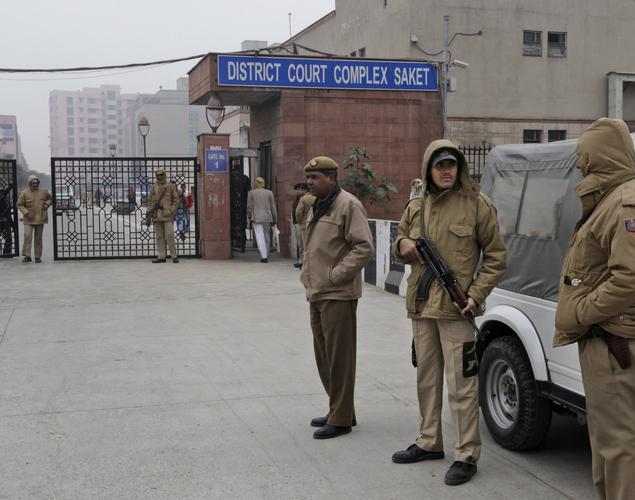January 7, 2014
INDIANAPOLIS: Dangerously cold polar air snapped decades-old records as it spread on Tuesday from the Midwest to southern and eastern parts of the US and eastern Canada, making it hazardous to venture outside and keeping many schools and businesses closed.
January 7, 2014
INDIANAPOLIS: Dangerously cold polar air snapped decades-old records as it spread on Tuesday from the Midwest to southern and eastern parts of the US and eastern Canada, making it hazardous to venture outside and keeping many schools and businesses closed.
Brutal, record-breaking cold descended on the east and south of US where many people have almost no idea how to deal with freezing weather.
In the Florida beach city of Pensacola, patches of ice sparkled in parking lots where puddles froze overnight. In Atlanta, which saw a record low of 6 degrees (-14 celsius), fountains were frozen over, pipes burst and cars wouldn't start.
"This is severely cold for these parts," said Brian Lynn, a National Weather Service meteorologist.
The cold broke records in Chicago, which set a local record Monday at minus 16 Fahrenheit (minus 27 celsius), and elsewhere.
Forecasters said some 187 million people could feel the effects of the "polar vortex" by the time it spreads across the US.
In Toronto, a message on Pearson International Airport's official Twitter account on Tuesday morning said "extreme cold (is) causing equipment freezing and safety issues for employees. Ground stop in effect until at least 9am."
PJM Interconnection, which operates the power grid supplying energy to more than 61 million people in parts of the Mid-Atlantic, Midwest and South, asked users to conserve electricity Tuesday because of the cold.
More than 15,000 customers in Indiana remained without power.
Trains, flights hit
More than 500 Amtrak passengers spent the night on three stopped trains headed for Chicago because of blowing and drifting snow in Illinois, but rail officials said some began arriving in Chicago later Tuesday.
Bob Oravec, a meteorologist at the Weather Prediction Center in College Park, Maryland, said the blast of frigid air raised concerns that roads wet from melted snow from a weekend storm would freeze over.
But there are signs things were returning to normal. Warmer temperatures — near or above freezing — were forecast for the Midwest.
JetBlue Airways, which stopped all scheduled flights to and from New York and Boston on Monday, planned to resume some flights Tuesday morning. Southwest Airlines operations in Chicago resumed Monday night, even if it was, as a spokesman for the Texas-based airline called it, "a trickle".
The Minnesota Zoo announced it would reopen to the public Tuesday. State lawmakers in Indiana planned to kick off their 2014 legislative session after a day's postponement.
And warmer temperatures — at least, near or above freezing — are in store for the Midwest. Indianapolis should reach 27 degrees F (minus 3 C) on Wednesday, and other parts of the central U.S. could climb above freezing later in the week.
Even International Falls, Minnesota, had something to look forward to. Wind chills dropped as low as minus 55 F (minus 48 C) Monday, but were expected to rebound to 25 below F (32 below C) Tuesday. By Friday, the low was expected to be 5 to 10 above zero F (minus 15 to minus 13), Oravec said.
In Canada, large parts of Saskatchewan and Manitoba were in a deep freeze Monday with temperatures near or below minus 22 F (minus 30 C) and wind chills colder than minus 40 F (minus 40 C).
In Newfoundland, about 5,000 customers remained without power because of rolling blackouts in recent days, but Premier Kathy Dunderdale said it wasn't a crisis and government services were still operating.
Record low tempertarures and deaths
Record lows were possible in the east and south, with highs in the single digits F (minus 17 to minus 13 C) expected Tuesday in Georgia and Alabama. Wind chills were expected to reach minus 10 F (minus 23 C) in Atlanta and minus 12 (minus 24 C) in Baltimore.
From the Dakotas to Maryland, schools and day care centers shut down.
For a big swath of the Midwest, the bone-chilling cold moved in behind another winter wallop: more than a foot (30 centimeters) of snow and high winds that made traveling treacherous.
Several deaths were blamed on the snow, ice and cold since Saturday, including the death of a 1-year-old boy who was in a car that went out of control and collided with a snowplow Monday in Missouri.
It took authorities using 10-ton military vehicles known as "wreckers" until early Monday to clear all the chain-reaction accidents caused when several semis jackknifed along snowy interstates in southern Illinois.
The crash stranded about 375 vehicles, but there were no fatalities or injuries, largely because motorists either stayed with their cars or were rescued and taken to nearby warming centers if they were low on gas or didn't have enough coats or blankets, said Jonathon Monken, director of the Illinois Emergency Management Agency.
Others got stuck in the snowdrifts, including the Southern Illinois men's basketball team, which had to spend the night sleeping in a church.
In the eastern United States, temperatures in the 40s and 50s F (from single digits to the low teens C) Monday helped melt piles of snow from a storm last week, raising the risk that roads would freeze over as the cold air moved in Monday night, said Bob Oravec from the Weather Prediction Center in College Park, Maryland. The snap was set to be dramatic; Springfield, Massachusetts, enjoyed 56 degrees F (13 C) Monday morning but faced an overnight low of 6 F (-14 C).
Utility crews worked to restore power to more than 40,000 Indiana customers affected by the weekend storm and cautioned that some people could be in the cold and dark for days.
Ronald G Smith Sr took shelter at an Indianapolis Red Cross after waking up the previous night with the power out and his cat, Sweet Pea, agitated in the darkness.
"The screen door blew open and woke me up, and it was cold and dark. I got dressed and I was scared, thinking, `What am I going to do? My cat knew something was wrong. He was jumping all over the place," Smith said. "This is brutal cold. The cold is what makes this so dangerous."
Officials in Chicago and other cities checked on the homeless and shut-ins for fear they might freeze to death on the street or in their homes.
In Canada, much of Saskatchewan and Manitoba were in a deep freeze Monday with temperatures near or below minus 22 F (minus 30 C) and wind chills colder than minus 40 F (minus 40 C).
In Newfoundland, about 5,000 customers remained without power because of rolling blackouts in recent days, but Premier Kathy Dunderdale said it wasn't a crisis and government services were still operating.
Only a few hardy souls braved the cold on the Nicollet Mall in Minneapolis, normally a busy pedestrian area. Many people downtown used the extensive heated skyway system, where it is warm enough to walk around in office attire. Nearly all stores on the skyway were open as usual.
Jersey Devil Pizza & Wings was not.
"Apologies … We are East Coast wimps. Too cold! Stay safe, see you Tuesday," read a sign taped to the door.
Courtesy: AP















































































































